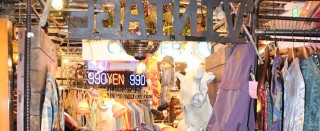Loading
Search
▼ Hand-me-downs: US Brands Find New Lease On Life In Japan
- Category:Shopping
TOKYO —For a glimpse of the latest fashion trends in Tokyo, venture to the Harajuku or Shimokitazawa shopping and entertainment districts. Renowned for narrow streets and off-the-beaten-track appeal, it is little wonder that independent live music venues, record stores, bars, and restaurants have sprung up in these areas. And so have fashion retailers, especially secondhand clothes outlets.
Many of these shops specialize in famed brands from European and American fashion houses, such as Dr. Martens, Burberry, and Levi’s.
Harajuku’s flirtation with all things foreign arguably goes back to the post-war period, when a housing complex — Washington Heights — that accommodated members of the US Armed Forces was located nearby.
In the Jingumae area of Harajuku stands Caliente, a secondhand clothes retailer established in 2000. The shop sells used and vintage items sourced from the West. Some items are 100 years old.
Caliente has a special focus on polo and dress shirts — especially those by US and British brands such as Ralph Lauren and Burberry — which retail for about ¥6,000 ($53). New Ralph Lauren shirts retail for $90–125 in the United States.
Footwear brands including Dr. Martens and Red Wing are also popular. Based in Red Wing, Minnesota, Red Wing’s hand-stitched boots were the brand of choice for the US military in the early- to mid-20th century.
Far out and flash
When it comes to trendsetting, Shimokitazawa—an area referred to by the cool kids as “Shimokita” — arguably has the greatest concentration of indie retail entrepreneurs in Tokyo.
Step Ahead stocks a wide selection of secondhand brands that have been sourced from the United States, such as Levi’s, Wrangler, North Face, and Champion, as well as non-brand-name items.
The shop’s owner is known to make monthly trips across the Pacific expressly for stock sourcing.
On the south side of Shimokitazawa Station lies Trademark, which has been in business for 10 years. Inspired by the most far-out trends of the 1970s and those that were flash in the ’80s, the store stocks secondhand and vintage apparel by Levi’s, Coach, and J-Crew, to name a few.
Sourced via seasonal trips to the United States, Trademark carries a wide range of apparel. Speaking to The Journal, co-founder Masaki Haruyama says, “I get secondhand items from the West Coast of America, from Los Angeles to Seattle and Washington.”
According to Haruyama, a good source for the required items is flea markets such as those that spring up every second Sunday next to the Rose Bowl Stadium in Pasadena, California. In addition, he relies on a network of US dealers who supply used clothes and antique wares.
Also in Shimokitazawa, Ocean BLVD similarly sources items from Europe and the United States, but its president, Miyata Hiroshi, is loath to disclose the precise route that apparel takes to its stores. Most items, a company spokesperson says, are sourced in Japan.
The company, established in 2004, specializes in US military-style clothes for women, and stocks high-end women’s clothing as well. Brands such as Burberry, Ives Saint Laurent, Chanel, and Levi’s are popular, according to the spokesperson.
Such is the magnetic power of Shimokitazawa for retailers in the thrift shop business that Kensho Nishimura, owner of the Stock and Ragla Magla shops in the area, relocated there this year after closing his businesses next to Tokyo Station.
“Shimokitazawa is the mecca of the thrift shop business in Japan,” he says.
According to Nishimura, church bazaars on the West Coast of the US are a good source for his wares.
“I go to the US whenever I need to stock up,” Nishimura says. And while he makes a number of trips abroad, he always keeps an eye on the dollar–yen exchange rate to ensure the best return on his investment.
Secondhand fun
Perhaps the king of used clothes retailers in Japan is DonDonDown on Wednesday. Founded in 1991, the shop retails both Japanese and non-Japanese fashion brands, including some from the United States. Based on the concept of “omoshiroi furugiten” (interesting second-hand clothes store), the company is intent on injecting a little fun and excitement into the used clothes shopping experience.
It has a unique business model that has helped it expand its footprint across the world.
Part of the company’s name — “dondon” — is a play on words in Japanese; it is an onomatopoeic word suggesting a continuous activity, as in this case an ongoing drop in price. In practice, an item in the shop drops 25 percent in price every Wednesday for one month. If, for example, you spot a sweater for ¥4,000 on week one, on Wednesday of week two it would be ¥3,000. The drop in price will continue every Wednesday until week four.
This retail model encourages customers to buy items in week one — when they are still “fresh,” as one does with fruit and vegetables in a market. Indeed, clothes at DonDonDown on Wednesday are coded with labels carrying designs of 10 kinds of fruit and vegetables. A carrot label, for instance, means the item is discounted.
Sourcing clothes by the kilo, the company buys used garments from customers in Tokyo, including stained items. Items that it cannot sell are exported to some 20 countries across Southeast Asia and Africa, according to a 2015 press release. There are 64 DonDonDown on Wednesday stores across Japan, including one in Shimokitazawa.
Custom Media publishes The Journal for the American Chamber of Commerce in Japan.
- March 8, 2016
- Comment (0)
- Trackback(0)


